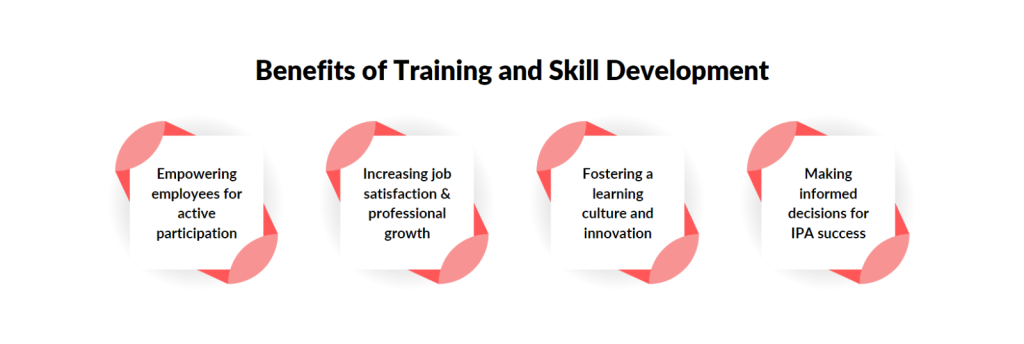Welcome to the sixth installment of our transformative 7-series blog, “Unleashing the Power of Intelligent Process Automation: A Roadmap to Revolutionize Your Business.” Get ready to embark on a captivating exploration of change management in Intelligent Process Automation (IPA) implementation.
Change is not just inevitable; it is the driving force behind progress and success in today’s ever-evolving business landscape. As organizations strive for innovation and operational excellence, Intelligent Process Automation (IPA) emerges as a game-changer. However, the true power of IPA lies not only in cutting-edge tools and algorithms but in the seamless integration of technology and human potential.
This blog unveils the hidden secrets of change management in IPA implementation. It’s time to equip your team with the knowledge, strategies, and mindset necessary to embrace change, navigate challenges, and maximize the benefits of IPA. From fostering a culture of innovation to addressing employee concerns, we will guide you through the art of effective communication and ensure a smooth transition toward a future of enhanced productivity and success. This is to say that the solution that IPA can create the solutions that we
Get ready to challenge the status quo and unleash the full potential of Intelligent Process Automation. Let’s embrace change, empower your team, and pave the way for a revolutionized business landscape. Buckle up for an exhilarating journey of transformation and growth.
Understanding the Role of Change Management
Change management is a critical component in the successful implementation of Intelligent Process Automation (IPA). It encompasses the strategies, techniques, and processes aimed at facilitating a smooth transition from the current state to the desired state when introducing automation into an organization. Understanding the significance of change management in IPA implementation is vital for achieving a seamless and successful transformation.
Change can affect various aspects at the organizational level, including operational processes, team dynamics, and overall performance. It requires careful planning and execution to ensure minimal disruption to day-to-day operations and maximize automation’s benefits. Neglecting the impact of change on the organization can lead to resistance, decreased productivity, and even project failure.
Organizations need to adopt a structured approach to navigate the challenges associated with change. This involves defining clear goals and objectives, establishing effective communication channels, and involving key stakeholders throughout the process. Organizations can foster employee engagement and ensure a smooth transition by providing a supportive environment and proactively addressing concerns and resistance.
A well-executed change management strategy will minimize the adverse effects of change and unlock the full potential of IPA. It helps employees understand the purpose and benefits of automation, mitigates resistance, and encourages a culture of continuous learning and improvement. Furthermore, it enables organizations to capitalize on the opportunities that IPA brings, such as increased efficiency, improved customer experiences, and enhanced competitiveness.
Remember, change is not just about technology; it is about empowering your people and cultivating a culture of innovation. Together, let’s pave the way for a seamless and transformative automation experience.
Fostering a Culture of Innovation

Creating an innovative culture starts with recognizing the importance of embracing change and encouraging employees to think outside the box. It involves promoting a growth mindset, where individuals are open to learning, unafraid of failure, and willing to take calculated risks. By instilling a belief that challenges are opportunities for growth, organizations can empower their teams to explore new ideas and approaches.
To promote innovation, organizations should encourage experimentation and provide a safe space for employees to test new concepts. This can involve allocating dedicated time for innovation projects, establishing innovation labs or sandboxes, and supporting cross-functional collaboration. By providing the necessary resources and support, organizations can foster an environment that encourages curiosity, exploration, and the generation of groundbreaking ideas.
Recognizing and rewarding innovation is also essential for sustaining an innovative culture. Organizations can implement recognition programs that celebrate innovative achievements and contributions. This can include incentives, such as bonuses, promotions, or public acknowledgment, to encourage employees to actively participate in the innovation process. By recognizing and appreciating innovative efforts, organizations send a clear message that innovation is valued and encouraged.
Addressing Employee Concerns
Implementing Intelligent Process Automation (IPA) brings significant changes to how work is performed, which can lead to concerns and resistance among employees. Addressing these concerns is vital for a smooth transition during the change management process. Effective communication, comprehensive training, and employee involvement are key strategies to mitigate resistance and gain employee buy-in.
Employee concerns regarding IPA often revolve around uncertainty about new technologies and their impact on their roles. Transparent communication is essential in addressing these concerns. By openly discussing the goals and benefits of IPA, organizations can alleviate fears and misconceptions. Emphasizing that IPA enhances employee capabilities and enables them to focus on more valuable tasks helps build confidence.
Comprehensive training plays a crucial role in addressing employee concerns. Organizations can alleviate anxiety and increase confidence by providing employees with the necessary skills and knowledge to work effectively with IPA. Tailored training programs that offer hands-on experience and ongoing support highlight the investment in employees’ professional development and the value of new skills in the digital era.
Involving employees in the IPA implementation process fosters a sense of ownership and helps address their concerns. Organizations demonstrate that employees are valued stakeholders by seeking their input, ideas, and feedback. This involvement can take various forms, such as forming cross-functional teams, seeking process improvement suggestions, or involving employees in testing and validation. Actively involving employees empowers them and ensures their concerns are heard and addressed.
During the change management process, approaching employee concerns with empathy and understanding is crucial. Providing channels for open dialogue, such as regular check-ins or Q&A sessions, allows employees to express concerns and receive clarifications. Approachable leaders and managers who actively listen to employee feedback provide reassurance and guidance throughout the change process.
Communicating the Vision and Benefits
Clear and effective communication is pivotal in gaining employee buy-in and driving successful Intelligent Process Automation (IPA) implementation. To ensure a smooth transition and maximize the benefits of IPA, organizations must articulate the vision and communicate the tangible benefits of automation in a compelling and relatable manner.
First and foremost, it is essential to clearly define and communicate the vision of IPA within the organization. This involves explaining how IPA aligns with the organization’s strategic objectives and how it contributes to long-term success. By linking IPA to broader goals, such as enhancing customer experiences, improving operational efficiency, or fostering innovation, organizations can inspire employees and help them understand the purpose and significance of the automation initiative.
When communicating the benefits of IPA, it is crucial to highlight the positive impact on employees and the organization as a whole. This includes emphasizing how IPA can streamline repetitive and mundane tasks, freeing up valuable time for employees to focus on more strategic and value-added activities.
Organizations should also emphasize how IPA can enhance job satisfaction by empowering employees to leverage their skills and expertise in more meaningful ways. Sharing real-life examples and success stories of how IPA has positively transformed similar roles or departments within the organization can bring benefits to life and make them relatable to employees.
To effectively communicate the vision and benefits of IPA, it is important to tailor the message to different organizational audiences. This involves understanding various stakeholders’ unique perspectives, concerns, and priorities and adapting the communication approach accordingly.
For example, when communicating with front-line employees, it may be beneficial to emphasize how IPA can simplify their daily tasks and improve their work-life balance. On the other hand, when communicating with senior leaders, focusing on the potential cost savings, operational efficiency gains, and strategic advantages of IPA may be more impactful.
Training and Skill Development
In the rapidly evolving landscape of Intelligent Process Automation (IPA), providing employees with adequate training and skill development opportunities is crucial for successful implementation. As organizations embrace automation and digital transformation, equipping employees with the knowledge and skills required to thrive in the IPA-driven environment is essential.
Training plays a vital role in preparing employees for the changes IPA brings. It not only ensures that employees understand the technology and its applications but also helps them adapt to new ways of working and leverage the full potential of automation. By investing in training programs, organizations empower their workforce to embrace the opportunities IPA presents and contribute to its success.
Organizations can employ different training approaches, such as workshops, online resources, and hands-on experiences. Workshops provide a structured environment for interactive learning and discussions. Online resources offer flexibility and accessibility through e-learning modules and virtual training platforms. Hands-on experiences, including simulations and practical projects, enable employees to apply knowledge and gain insights through real-world scenarios.
Upskilling and reskilling employees are also vital components of training initiatives in the IPA-driven environment. Upskilling involves enhancing employees’ existing skill sets to align with the requirements of IPA implementation. This could include training employees on new automation tools and technologies, data analytics, process optimization techniques, or collaborative problem-solving.
Reskilling, on the other hand, involves equipping employees with entirely new skills to perform different roles or responsibilities in the transformed work environment. This could involve training employees to become automation champions, process analysts, or automation solution architects. By upskilling and reskilling employees, organizations maximize their potential and create an agile, adaptable workforce capable of driving automation initiatives forward.

Monitoring and Adapting
Continuous monitoring and evaluation play a critical role in the dynamic landscape of change management during Intelligent Process Automation (IPA) implementation. It is essential to assess the progress of the change efforts, gather feedback from employees and stakeholders, and adapt the approach as needed to ensure a successful transition and maximize the benefits of IPA.
The act of monitoring change allows organizations to measure their strategies’ effectiveness. Regular assessments help recognize gaps, track progress toward goals, and implement necessary adjustments. KPIs and milestones provide data for informed decision-making, boosting change management tactics.
Collecting feedback from employees and stakeholders is central to the monitoring process. Their experiences and insights offer invaluable input on the efficacy of change strategies, aiding in identifying potential concerns or areas of refinement. This feedback can be obtained via multiple channels, fostering a culture of open communication.
Maintaining flexibility and a willingness to adapt is crucial in change management. As the organization changes with IPA implementation, it’s important to remain responsive to evolving needs. This could mean revisiting the change plan, modifying strategies, altering communication based on new insights, and promoting a continuous improvement ethos.
Organizations can tackle challenges head-on, exploit opportunities, and ensure IPA’s successful adoption by perpetually overseeing and adapting the change management process. This approach supports goal alignment, enhances employee engagement, and secures long-term positive impact.
Equally important is internal alignment among leadership- particularly between the CTO and CFO. As this strategic partnership strengthens, it not only supports smoother implementation but also ensures the right balance between innovation and financial accountability
Conclusion
In this blog, we have explored the critical role of change management in Intelligent Process Automation (IPA) implementation. We have discussed the significance of fostering a culture of innovation, addressing employee concerns, communicating the vision and benefits, providing training and skill development, and continuously monitoring and adapting the change process.
As you embark on your IPA journey, we encourage you to adopt a proactive approach to change management. Leverage this blog’s strategies and insights to navigate the challenges, engage your team, and achieve successful IPA implementation. Remember that change is a journey, and by fostering a supportive and inclusive environment, you can lay the foundation for long-term success.
Stay tuned for the final blog in our 7-series, “Evaluating Success: How to Measure the Impact of Your IPA Implementation.” We will dive into the essential aspects of measuring the effectiveness of your IPA initiatives and understanding their impact on your organization.
Get ready to uncover the insights and metrics to help you evaluate your IPA implementation and guide future improvements. Let’s take the next step in our automation journey and revolutionize how we work.
Don’t miss out on this exciting concluding last blog to our series!




